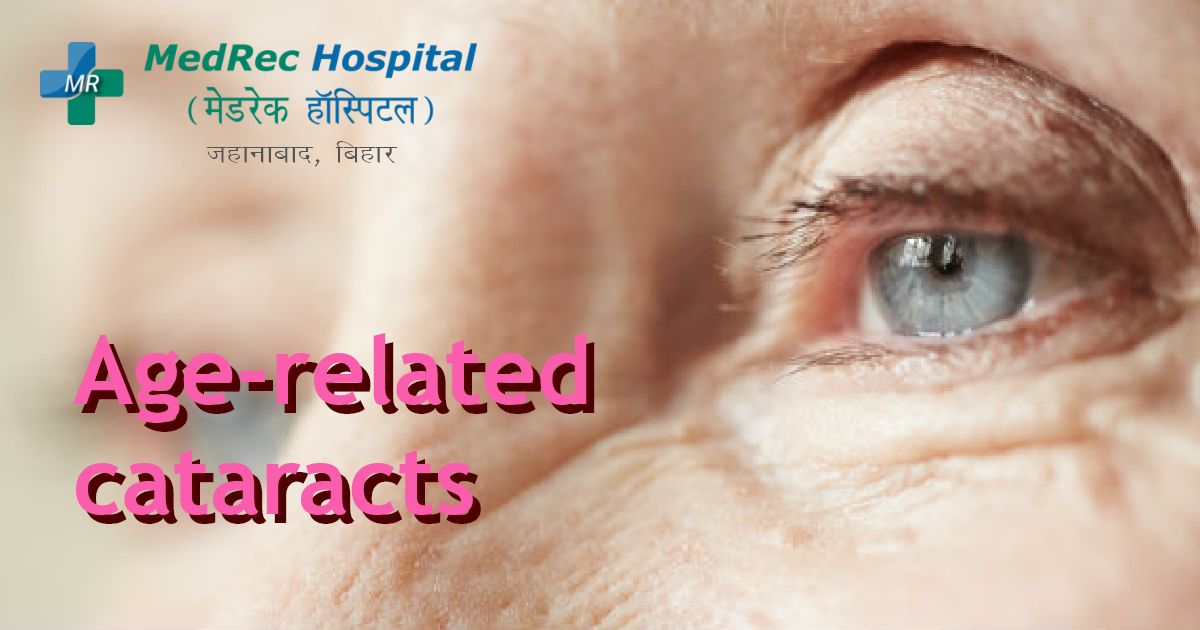
Age-related Cataracts: A common medical issue for patients.
770
When the lens, a little clear disc inside your eye, acquires clouded spots, it becomes a cataract. These patches typically enlarge with time, resulting in impaired, foggy vision and ultimately blindness.
Our lenses are typically as clear as glass when we are young, allowing us to see through them. They start to become frosted as we age, and this restricts our vision.
A cataract affects both eyes. They might not always appear in both eyes at the same time or be identical. They are more prevalent in older persons and make it difficult for you to complete daily tasks such as driving.
Also susceptible to cataracts are infants and young children.
Stronger brightness and glasses can initially help you manage cataracts. However, if normal activities are hampered by your poor eyesight, cataract surgery may be necessary. The good news is that cataract surgery is a risk-free, successful treatment.
Causes
The majority of cataracts occur when the tissue that makes up the eye's lens changes due to age or trauma. The lens's proteins and fibers start to degrade which obstructs your vision.
Your risk of cataracts may be increased by genetic abnormalities that can result in health issues. Other eye diseases, previous eye surgery, or other disorders like diabetes might also lead to cataracts. The long-term use of steroid medicines can also result in cataract development.
How cataracts develop
A clouded lens is a cataract. Your eye's pigmented portion is in front of the lens. The retina, the light-sensitive membrane in the eye, receives sharp images from the lens by focusing light that enters your eye.
The lenses in your eyes get thicker, less flexible, and less transparent as you get older. Proteins and fibres within the lenses deteriorate and clump together as a result of ageing and other medical disorders, clouding the lenses.
The cloudiness gets heavier as the cataract progresses. A cataract prevents your retina from receiving a well-defined image by scattering and blocking light as it travels through the lens. Your eyesight becomes hazy as a result.
Both eyes often acquire cataracts. There may be a disparity in vision between the two eyes due to the cataract in one eye being more advanced than the other.
How to check if you have Cataracts?
If you have any of the following symptoms, please seek immediate medical advice.
- You have cloudy or blurry vision.
- You find it difficult to see in low light because lights are blinding.
- If you wear glasses, you could believe that they are not filthy even though your lenses need to be cleaned.
Risk Factors
These factors increase your chance of getting cataracts:
- Diabetes
- Too much exposure
- Smoking
- Obesity
- Having high blood pressure
- Eye inflammation or damage
- Long-term usage of drugs
- Excessive alcohol consumption
Symptoms
Cataract symptoms include:
- A vision that is cloudy or dim
- Increasing difficulty in night time vision
- A sensitivity to glare and brightness
- Brighter lighting is required for activities like reading.
- "Halos" around lights being perceived
- Prescription for glasses changing frequently
- Colour fading in vision
- Seeing double vision in just one eye
When a cataract first develops, it may only impact a tiny portion of the eye's lens, and you might not notice any vision loss. Your lens becomes increasingly distorted as the cataract enlarges. The symptoms could become stronger as a result.
Please seek medical assistance if you experience any of these symptoms.
Prevention
There is no scientific evidence to support any methods for cataract prevention. However, doctors recommend a number of methods that can be useful in the prevention of cataracts. These are:
- Regular eye check. Eye exams can aid in the early detection of cataracts and other eye issues.
- Give up smoking. Ask your doctor for advice on quitting smoking.
- Managing medical conditions. If you have diabetes or other illnesses this can increase your risk of cataracts. Please consult your medical team for further advice.
- Eat a balanced diet. You can make sure you're receiving a lot of vitamins and nutrients which support eye health.
Treatments
Stronger glasses and better light may temporarily assist if your cataracts are not too serious. When cataracts progress, you'll eventually require surgery to remove the damaged lens and replace it.
If you want to know if surgery is correct for you, talk to your eye doctor. When your cataracts start to negatively impact your quality of life and make it difficult for you to carry out regular daily tasks like reading or driving. Most eye doctors recommend cataract surgery.
Cataract Surgery
The clouded lens is removed during cataract surgery, and a new, clear artificial lens is placed in its place. An intraocular lens is a synthetic lens that replaces your natural lens in the eye. It is still an important component of your eye.
Complications of Cataracts
Although there is a chance of haemorrhage and infection, cataract surgery is typically safe. Retinal detachment is more likely after cataract surgery. If cataracts are left untreated, it can lead to loss of vision and further complications for the patient.
Please access medical support if you have any cataracts or its indicating symptoms.
For further information please access the following resource
MedRec Hospital- https://medrechospital.com/
Emergency : +91 89686 77907
Front Desk : +91 98018 79584
Page last reviewed: Mar 2, 2023
Next review due: Mar 2, 2025







.jpg)
.jpg)
.jpg)
.jpg)
.jpg)
.jpg)